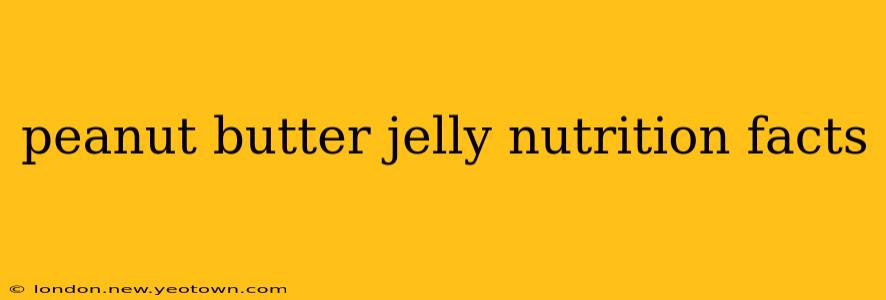The Surprisingly Sweet and Savory Nutrition Facts of Your Peanut Butter and Jelly Sandwich
The classic peanut butter and jelly sandwich: a childhood staple, a lunchtime hero, and a surprisingly complex nutritional package. We're diving deep into the nutritional facts of this beloved combo, exploring its benefits, drawbacks, and variations to help you make informed choices about this everyday treat.
This isn't just about calories; we'll uncover the vitamins, minerals, and macronutrients that make up this seemingly simple sandwich and address common questions surrounding its nutritional value. Prepare for a delicious journey into the world of peanut butter and jelly!
What are the nutritional benefits of a peanut butter and jelly sandwich?
A peanut butter and jelly sandwich, when made with whole-wheat bread and natural peanut butter, offers a surprisingly well-rounded nutritional profile. Let's break it down:
-
Protein Powerhouse: Peanut butter is a fantastic source of protein, crucial for building and repairing tissues, keeping you feeling full and satisfied. This helps regulate blood sugar levels, preventing those mid-afternoon energy crashes.
-
Healthy Fats: Peanut butter contains monounsaturated and polyunsaturated fats, the "good" fats that are beneficial for heart health. These fats contribute to satiety and support various bodily functions.
-
Carbohydrate Energy: The jelly (especially if it's fruit-based) provides carbohydrates, your body's primary source of energy. These carbohydrates fuel your activities throughout the day.
-
Fiber Boost (with the right ingredients): Whole-wheat bread adds fiber to the mix, which aids digestion, promotes regularity, and contributes to overall gut health. Choosing whole-wheat bread over white bread is a significant nutritional upgrade.
-
Vitamins and Minerals: Depending on the ingredients, you can get a dose of essential vitamins and minerals like vitamin E (from peanuts), potassium (from both peanuts and some jellies), and various B vitamins.
How many calories are in a peanut butter and jelly sandwich?
The calorie count of a peanut butter and jelly sandwich can vary wildly depending on the ingredients and portion sizes. A typical sandwich made with two slices of white bread, two tablespoons of peanut butter, and two tablespoons of jelly can range from 300 to 400 calories. However, opting for whole-wheat bread and reducing the amount of peanut butter and jelly can significantly lower the calorie count. Always check the nutrition labels of your specific ingredients for accurate calorie information.
Is peanut butter and jelly healthy for weight loss?
While a peanut butter and jelly sandwich can be part of a healthy weight loss plan, it's crucial to be mindful of portion sizes. The high protein and fiber content can help keep you feeling full, reducing overall calorie intake. However, it's important to choose healthier options, such as whole-wheat bread and natural peanut butter (without added sugars or oils). Overconsumption can still lead to weight gain due to its calorie density.
What are the disadvantages of eating peanut butter and jelly sandwiches?
Despite its benefits, a peanut butter and jelly sandwich isn't perfect. Here are some potential drawbacks:
-
High Sugar Content: Many commercially available jellies are high in added sugars. Opting for fruit-based spreads with minimal added sugar is crucial for minimizing this downside.
-
Sodium Levels: Some peanut butters and breads contain significant amounts of sodium. Check nutrition labels and choose lower-sodium options to manage sodium intake.
-
Potential Allergens: Peanuts are a common allergen. Be aware of potential allergic reactions and always check ingredients for potential allergens.
Are there healthier alternatives to peanut butter and jelly?
Absolutely! While the classic combo is delicious, you can explore healthier variations:
- Use whole-wheat bread: This significantly increases fiber content.
- Opt for natural peanut butter: Avoid added sugars and oils.
- Choose fruit-based spreads with minimal added sugar: Look for jellies with lower sugar content or even consider homemade fruit spreads.
- Experiment with alternatives: Try almond butter, sunflower seed butter, or other nut butters for variety and different nutritional profiles.
The peanut butter and jelly sandwich is a versatile and customizable food. By making smart choices about ingredients and portion sizes, you can enjoy this classic treat while reaping its nutritional benefits and minimizing potential drawbacks. It’s a reminder that even the simplest foods can be part of a healthy and balanced diet!

